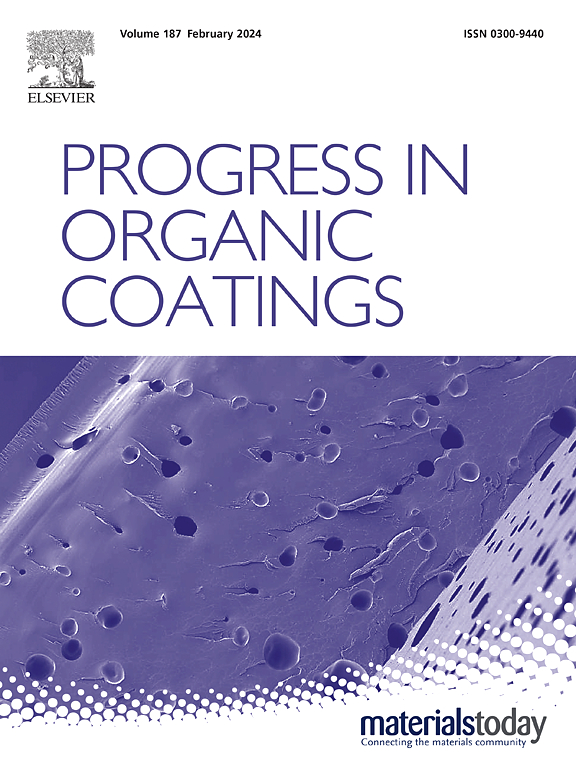Amino-functionalized MXene/cyclodextrin nanoreservoir reinforced epoxy for durable dual-function active/barrier anti-corrosion coating
IF 6.5
2区 材料科学
Q1 CHEMISTRY, APPLIED
引用次数: 0
Abstract
A novel multifunctional nanohybrid (βSMX) was developed for the first time by decorating amino-silane-modified MXene (SMX) with an innovative nanocontainer, beta-cyclodextrin (β-CD), specifically designed for corrosion protection applications. The βSMX structures were designed to incorporate both organic (benzimidazole, B) and inorganic (Zn2+ cation, Z) inhibitors (βSMX@BZ), and their synergistic effects were comprehensively analyzed to develop a multifunctional intelligent anti-corrosion epoxy system. The βSMX@BZ nanohybrids were successfully synthesized, as confirmed through FTIR, Raman, XRD, TGA, FE-SEM, and EDS analysis. The pH-triggered release of corrosion inhibitors from βSMX@BZ nanoreservoirs was evaluated in NaCl solutions at three pHs. The release rates of the inhibitors from the β-CD inclusion complex, including zinc ions and benzimidazole molecules, were quantified using ICP-OES and UV–Vis spectroscopy. Electrochemical methods (polarization and EIS) combined with surface analysis were utilized to analyze the corrosion protection efficiency of functionalized MXene nanocontainers loaded with inhibitors in saline solution. Incorporating βSMX@BZ nanostructures within the scratched epoxy coatings led to a substantial rise in total resistance, up to 4.6 times. FE-SEM/EDS analysis demonstrated that a protective layer created by the released inhibitors is developed in the defected area. The existence of the βSMX@BZ nanohybrids within the coating substantially improved barrier performance, providing sustained corrosion protection for 7 weeks (|Z|0.01Hz = 12.59 GΩ.cm2). The epoxy coating reinforced with βSMX@BZ nanocomposite demonstrated strong corrosion protection, excellent adhesion strength, and exceptional mechanical performance. According to the findings, the βSMX@BZ nanoreservoirs ensure that the organic coatings have both passive (ion-water barrier) and active (self-healing) properties.

求助全文
约1分钟内获得全文
求助全文
来源期刊

Progress in Organic Coatings
工程技术-材料科学:膜
CiteScore
11.40
自引率
15.20%
发文量
577
审稿时长
48 days
期刊介绍:
The aim of this international journal is to analyse and publicise the progress and current state of knowledge in the field of organic coatings and related materials. The Editors and the Editorial Board members will solicit both review and research papers from academic and industrial scientists who are actively engaged in research and development or, in the case of review papers, have extensive experience in the subject to be reviewed. Unsolicited manuscripts will be accepted if they meet the journal''s requirements. The journal publishes papers dealing with such subjects as:
• Chemical, physical and technological properties of organic coatings and related materials
• Problems and methods of preparation, manufacture and application of these materials
• Performance, testing and analysis.
 求助内容:
求助内容: 应助结果提醒方式:
应助结果提醒方式:


